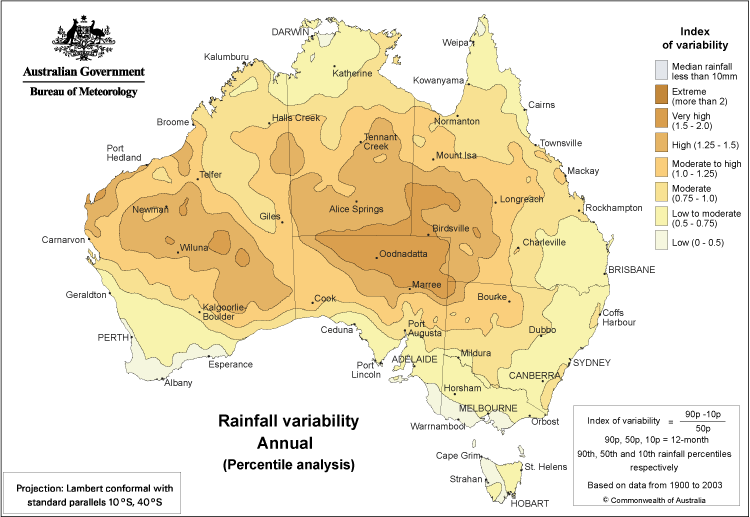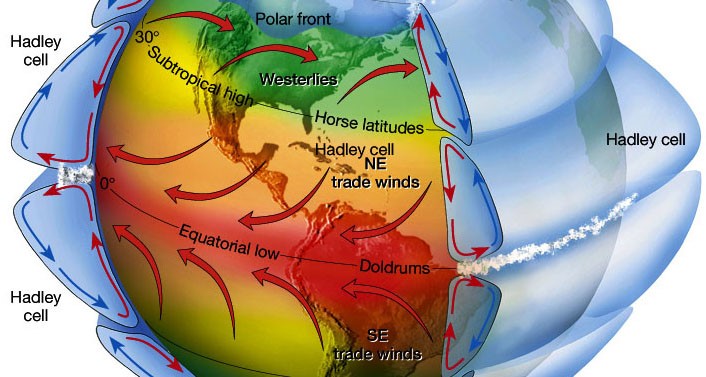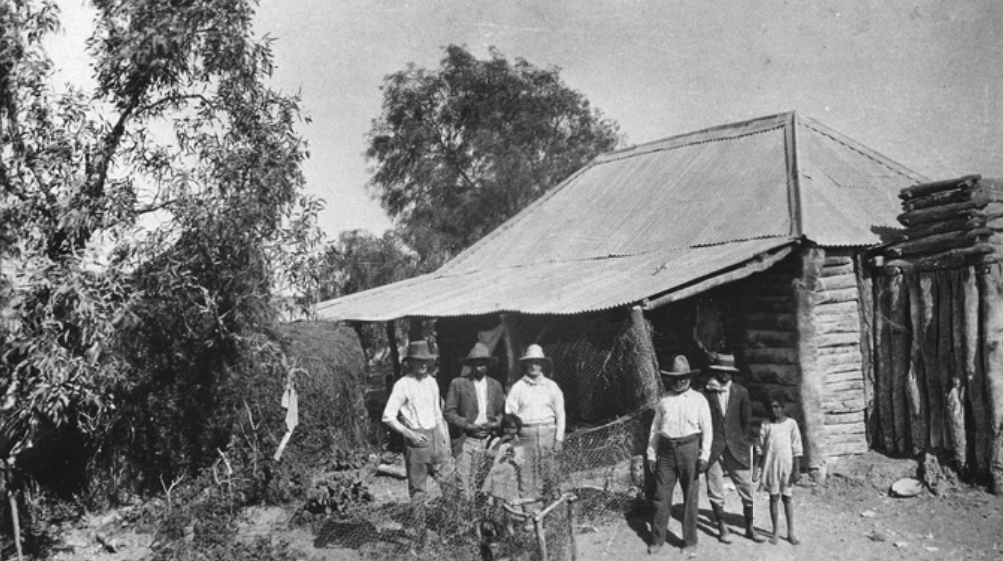GEOGRAPHIC EXTREMES SOCIETY
AUSTRALIAN RECORDS
Drought
How often have we been told that Australia is the ‘driest continent on Earth’? That is, of course, if we exclude the cold polar deserts of Antarctica. So, it is said ‘Australia is the driest permanently inhabited continent on Earth’. It is not only dry, but large sections of this continent endure a highly variable rainfall pattern creating boom and bust scenarios. It’s those times of ‘bust’ where we see droughts play out across Australia. If rainfall patterns were regular across the continent, the vegetation and animal life would be far different. Instead, we see multiple years of well below average rainfall, followed by a year or two rainfall very much above average.
As the Bureau of Meteorology’s variability map below shows, the arid centre and west of Australia suffer a far higher degree of climate variability. The only areas to show any reliability of weather patterns are parts of southern Australia and two small sections of northern Australia. So what does this map of variability tell us? It is that Australia suffers from long extended droughts accompanied by short periods of intense rainfall.

Australian Climate Variability Map Image: BoM
If climate variability leads to drought, how is this measured? The Bureau of Meteorology defines drought as a period of minimum three months in which the rainfall is in the lowest 90% decile. It isn’t a poor definition, but it doesn’t take into account evaporation or condensation figures, which mainly affects vegetation. Three months of drought over summer has a far more significant impact on the environment compared to three months of drought over the colder months.
The vast majority of Australia climate is categorised as arid or semi-arid. The Environment Department in Canberra defines semi-arid lands as receiving 250mm-350mm annual rainfall with arid regions receiving less than 250mm. A different but more generous definition is supplied by Geoscience Australia whose broader terms allows for arid lands as those which receive less than 500mm of annual rainfall. This definition works well for the majority of the hot Australian continent, but elsewhere can be misleading. Cities that receive 500mm of rainfall like Warsaw, Athens, Copenhagen and rainy old London would qualify as borderline arid regions.

Australian Arid Regions Map Image: J Davis 2013
The driest regions of Australia lie between the Tropic of Capricorn and down to latitude 30 degrees south. Throughout the world, these latitudes both north and south of the equator are where the major deserts reside.
In northern Africa, you find the massive Sahara Desert and the Afar Depression, while southern Africa has the Namib Desert. South America has the Atacama Desert, China the Gobi Desert, while in North America you’ll find the deserts of Arizona, California, and northern Mexico. The presence of deserts in these regions is due to the atmospheric circulatory formations we call Hadley Cells. These are air currents which distribute heat throughout tropical and subtropical zones. Simply put, warm air travels towards the equator, and gathers moisture before rising high, to the very top of the troposphere. The moist air is then pushed back towards the subtropics, cooling and releasing its moisture load before eventually sinking to the surface around 30o latitude as dry air.

Hadley Cells. Image: Lutgens et al 2007
Hadley Cells help to explain the presence of Australian deserts. Still, the droughts experienced around the continent are predominately associated with El Niño patterns in the Pacific which primarily affect the eastern section of the continent and the corresponding positive Indian Ocean dipole circulations in the west. When both the El Niño and positive Indian Ocean dipole coincide, Australia receives its most severe droughts.
Severe drought in Australia
Throughout Australia’s recorded meteorological history, one of the most significant droughts has been the
- Federation drought from 1896 to 1902.
- the WWII drought from 1937 to 1946.
- the 1960s,
- 1980s,
- 1990s,
- culminating in the millennium drought from 2001 to 2009.
Driest State in Australia
When it comes to drought, South Australia typifies the continent’s lack of rainfall, where arid or semi-arid country covers 90% of the state.

Australian Average rainfall. Image BoM
Driest township in Australia
Where is Australia’s driest locality? To find this, the best place to begins our search is the deserts which surround Lake Eyre and the town which claims the title, Oodnadatta. There are other worthy claims from Charlotte Waters, just inside the Northern Territory border, down to Marree and regions around the Birdsville Track. Another claim to the driest part of the continent was the triangle made between the towns of Birdsville, Tibooburra, and Thargomindah. All these regions are notoriously dry.
Oodnadatta claims the title of being the driest town in Australia. However, the Bureau of Meteorology records shows that the region to the south of Lake Eyre has marginally less rainfall. According to the Bureau’s data, the township of Marree is the driest town in Australia.
Oodnadatta – 175.8mm
Marree – 161.8mm
Marree Aero – 142.2 mm (only 20 years of records)

Maree. Driest town in Australia. Image: SA Tourism
Even though Oodnadatta’s claim to be the driest town in Australia doesn’t stack up, all the localities surrounding Lake Eyre are parched.
Driest locality in Australia
The locality of Kanowana Station, sited along a channel of the Cooper Creek, eighty-five kilometres east of the Birdsville Track has the Bureau of Meteorology’s lowest rainfall figures. From 1888 to when its abandonment in the massive drought of 1939, daily rainfall was recorded by tough pioneers at the station’s homestead. The Kanowana Station rain gauge gets a meagre average annual rainfall of just 116.2 mm.
Regions close to Kanowana Station, there have been claims made for the mantle of ‘driest locality’. The nearby Mulka Bore averages 121.6mm annual rainfall. A little further to the north, Mungerannie is genuinely dry as well. The long-term average at Mungerannie is just 130.6mm of rainfall.

Kanowana Homestead. Driest Locality in Australia. Image: SA Library
Drought Records
GES Record: Driest State South Australia Ninety percent classified as arid or semi-arid (Source: Geoscience Australia)
GES Record: Driest Town in Australia – Marree 161.8mm average rainfall p/y (Source: Bureau of Meteorology)
GES Record: Driest locality in Australia – Kanowana Station, 116.2mm average rainfall p/y (Source: Bureau of Meteorology)
The Geographic Extremes Society welcomes any input as to the veracity of these records and we encourage everyone to contribute to these extreme records by contacting us to initiate the discussion
